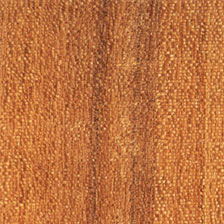Bete

Other names
Mansonia, African black walnut, African walnut
Scientific Name
Mansonia altissima
Family
Sterculiaceae
Description
Bete or Mansonia (Mansonia altissima) ranges in height from 100 to 120 feet. The heartwood can be yellow-brown, grey-brown or light mauve; the purple color of fresh-cut mansonia will usually fade. The wood typically has light or dark bands and can have a wide variation in its coloring. The sapwood is much lighter, usually white, and is sharply delineated. Mansonia is usually straight-grained but can be interlocked. It has a fine, smooth and even texture. It lacks a distinct odor or taste and is moderately lustrous.
Density
(H=12%) : 0,65
Treatability
moderately permeable
Seasoning
Mansonia will dry rapidly with few problems or degrade. However any knots in the wood may split and shakes will extend. Some distortion in length can occur, as well
Stability
Poorly stable
Classe de durabilité
Mansonia is very durable in regards to decay resistance, and is also resistant to termite and insect attack. Mansonia has good outdoor weathering properties.
Workability
Mansonia is considered an easy-to-work wood with both hand and machine tools. It has a high bending strength, low stiffness, medium shock resistance and high crushing strength. It will work well for steam bending only when the wood is knot-free. Experts recommend bending the wood when green to avoid buckling and fracture. Mansonia has a slight blunting effect on cutting edges. It screws and nails with no problems. It is easy to glue and will finish extremely well.
End-Uses
- Cabinetwork (high class furniture)
- Sliced veneer
- Veneer for back or face of plywood
- Interior joinery
- Interior panelling
- Moulding
- Flooring
- Turned goods
- Exterior joinery
- Rolling shutters
- Shingles
- Ship building (planking and deck)
- Light carpentry
- Glued laminated